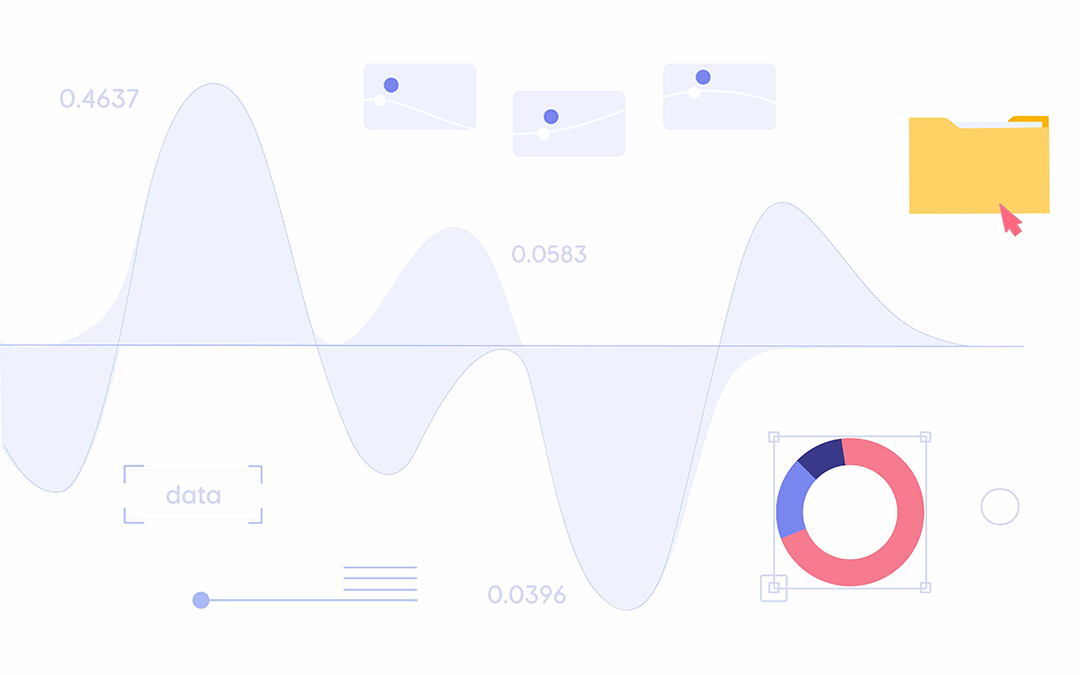“Without data, you’re just another person with an opinion”, W. Edwards Deming
Data and technologies have become the drivers of innovations and competitiveness in today’s constantly changing business environment. During the recent decade, companies have been making efforts to transform their business processes and culture to turn into data-driven organizations.
According to the survey by Wavestone [1] conducted in early 2024, leading companies continue investing in data and analytics, as they expect it to deliver business value. Also, the company’s executives recognize that building a data-driven organization requires time and effort.
In this article, we’d like to explore the main characteristics of a data-driven organization, the greatest impediments companies face in this way as well as provide useful tips on how to succeed in becoming a data-driven business.
What Is A Data-Driven Organization?
In a nutshell, a data-driven company incorporates data in every process and leverages data-driven insights to make a variety of business decisions. At the same time, the talent component shouldn’t be left aside: data alone cannot lead companies to success without human expertise to use in an efficient way.
The primary goal of becoming a data-driven organization is to improve decision-making, which in turn will provide customers with better products or services and as a result, increase profitability and facilitate business growth. Let’s now review the benefits of creating a data-driven organization in more detail.
What are the benefits of becoming a data-driven organization?
Improved decision-making process
Having access to real-time insights and business metrics helps business organizations determine trends and make strategic data-driven decisions without assumptions. In turn, this makes forecasting, risk management, and strategic planning more effective.
Enhanced operational efficiency
Leveraging data analytics allows companies to streamline their operations, detect inefficiencies, and optimize processes. This optimizes costs, reduces waste, and increases productivity. In addition, automation of data collection and analysis helps save employees’ time for more strategic or creative work.
Competitive advantage
Data-driven organizations are more competitive, as they can use data to identify market opportunities quickly and effectively, understand competitive dynamics, timely respond to market changes and evolving customers’ needs.
Better customer experiences
Data-driven insights help companies better understand customers’ preferences and needs. As a result, they can create personalized marketing campaigns, recommend certain products, and improve customer experience, which in turn increases their satisfaction and loyalty.
More effective risk management
Data analytics helps companies detect and respond to risks more effectively. They can monitor essential risk indicators, review historical data, forecast possible problems, and develop a data-driven strategy for risk mitigation.
Now that the benefits of data-driven organizations are clear, let’s answer the question: What does it mean to be a data-driven organization?
Characteristics of Data-Driven Organizations
McKinsey consultancy suggests that the data-driven enterprise of 2025 will be characterized by certain processes [2]. Here are the most significant transformations.
- Embedding data in every decision, interaction, and process.
It means that the majority of employees will regularly use data in their work, including quick and efficient problem-solving. Basic day-to-day operations will be automated, and people will be able to focus more on innovation, collaboration, and communication.
- Real-time data processing and delivery.
Customers, employees, and partners will get more advanced insights thanks to vast networks of connected devices that will transmit data and insights in real time.
- Providing integrated and ready-to-use data by flexible data stores.
Combining flexible databases (e.g., time-series databases or graph databases) with advanced technology and architecture will make it possible to create data products, such as “customer 360” and digital twins.
- Expanding the chief data officer’s role to generate value.
CDOs with their teams will work in partnership with business teams to find new ways of using data, creating a comprehensive enterprise data strategy, and developing new sources of revenue as a result of monetizing data services and data sharing.
- Prioritization and automation of data management.
Data privacy, ethics, and security will be treated as areas of required competency. Data resilience will be ensured thanks to automated and frequent backup procedures. AI tools for data management will become available. These efforts will contribute to building greater trust in both the data and the way it’s managed.
Therefore, these characteristics can be considered as a sort of target points that organizations can look to on their way to becoming data-driven. Now, let’s figure out the main roadblocks that impede this data-driven process.
Main Hurdles That Prevent Companies From Becoming Data-Driven

We can distinguish two major groups of factors that create roadblocks for companies striving to become data-driven – the first group embraces cultural issues, and the second one refers to data challenges.
Cultural challenges
The NewVantage Partners’ survey [6] shows that for the fifth year in a row, most business leaders (92.2%) point to cultural challenges as the biggest hurdles for their companies to become data-driven. Culture in this case refers to people, processes, and change management. On the one hand, such results are unexpected — it seems that companies have put in lots of effort to change their culture and overcome people’s resistance. On the other hand, these changes don’t happen overnight, especially when it comes to large organizations with firmly established processes. For example, some experienced business leaders may rely more on their own expertise or even gut feeling than on data.
One more side of this problem is a lack of talent able to convert the incoming data into business value. As we’ve stated earlier, the data alone cannot deliver better business outcomes, but requires human expertise for that. But as technologies get more and more sophisticated at breakneck speed, it takes more time for people to acquire skills to work with them.
Finally, we should mention the role of leadership in this process. Even though the role of Chief Data Officer is well-established in companies, the above-mentioned survey has shown that only in a third of the organizations CDOs’ role is successful and clearly defined.
Data-related challenges
A lack of proper data management
Firstly, organizations are flooded with data coming from various sources these days. Compared to several years ago, the amount of data that companies have to deal with has increased exponentially and will continue to grow year after year. Of course, such a trend indicates that they need new approaches to data storage and management, and the old methods aren’t enough to cope with myriads of incoming information. As a result, data is often siloed and unstructured, which makes it difficult to derive business value from it. Companies cannot become data-driven without proper data storage and management.
Ethical data use
The second challenge refers to responsible and ethical data use, which has become a matter of concern related to data management and ownership [3]. Companies have to find a balance between taking advantage of the data they collect and using it responsibly when it comes to people’s privacy not to lose their customers’ trust.
A lack of data strategy in place
Thirdly, the survey by NewVantage Partners has shown that only 30% of business organizations have a clearly defined data strategy. It means that most companies are drowning in the myriads of data without a clear understanding of how this data can help them generate value. In addition, it can be interpreted differently by employees; as a result, the analysis of the same data may end up with different results, which will make it impossible to derive real value from such ambiguity. Becoming a data-driven organization is unrealistic without a defined strategy and the idea of how the collected data will be used, what processes it can improve, and what problems it’s expected to solve.
Now, let’s explore what steps companies can take to come closer to becoming data-driven.
How to Become a Data-Driven Organization: Useful Tips
As we can conclude from the NewVantage Partners survey, companies have already made certain steps towards leveraging big data and AI to improve their processes and decision-making. However, there’s much work to be done as well. What should they focus on at this stage?
Continue working on culture development
Creating a data-driven culture is a comprehensive and collective process involving both leadership and every employee of an organization. There are several important things that must be taken into account.
- Developing a data-driven culture should always start from the top. A company’s senior management sets the example for the rest of the organization and advocates a data-driven approach among other employees by showing the value of data.
- Data should be incorporated into employees’ daily work and simplify it. Also, people should be encouraged to experiment with data and share their insights regarding the value that can be obtained from it. In such a way, each employee will contribute to establishing a data-driven culture across an organization,
- Employees should be provided with relevant training at the right time. Instead of choosing a comprehensive training program most of which will be soon forgotten without practice, it’s better to offer courses with immediate practical utility. [4]
- “Fail fast, learn faster”: this means that even when some of the data-driven initiatives are unsuccessful, companies should learn from their failures as quickly as possible. [3]
Read more: Change Management Best Practices: Overcoming Pitfalls of Change Implementation
Make sure that your company has the right data strategy
As long as the data strategy is still underdeveloped in a great number of companies, we’d like to consider it in more detail. Bernard Marr, a world-famous futurist, influencer, and thought leader in the fields of business and technology, suggests the following components of an effective data strategy [5].
- Determine what business problem you need to solve with the data: instead of starting with data itself, it’s better to think of your company’s needs and objectives.
- Think of the data required for previously determined business needs and objectives.
- Decide how the necessary data will be analyzed, i.e. you will get insights from the data collected.
- Outline the ways of reporting and presenting the data-driven insights: it’s necessary to find understandable ways to present the insights to decision-makers.
- Determine what software and hardware you will need.
- Map out an action plan that will turn the developed strategy into reality.
The developed data strategy is a good means to prepare business leaders and employees for work with the data to derive the most valuable insights from it.
Apply data-driven project management

In project-based organizations, the data-driven approach must be applied to the project management process, too. Data-driven project management uses data-driven insights to support project managers in making the right decisions to improve project outcomes. Data analytics and management are often facilitated by artificial intelligence, so data-driven project (and resource) management is supported by AI-powered project/resource management software.
Read more: 5 Essential Questions About Data-Driven Project Management
Let’s take a look at Epicflow, an AI-driven multi-project resource management solution, to illustrate how such a tool contributes to efficient project and resource management.
Epicflow facilitates the successful management of multiple projects running concurrently thanks to task prioritization, preventing people from overload, and timely detection of bottlenecks. Here are the main functions that involve the use of data combined with AI for more efficient workflow and better outcomes.
Automatic prioritization of projects and tasks
Setting the right priorities is the most important initial step in the work on multiple projects. For this reason, the Epicflow system analyzes necessary project data and automatically creates a list of tasks ranked according to their priorities. As a result, each team member knows which of their assignments is the most constrained and must be completed as soon as possible. In addition, Epicflow provides a prioritized list of all projects running in an organization, so that a project manager is always in the know what they should focus on. As any changes occur in the system (tasks are completed, resources are reallocated), the priorities are recalculated right away. Therefore, such a function makes a project manager’s work much more simple in a complex multi-project environment.
Bottleneck detection in real-time
Epicflow analyzes the data you input to provide real-time insights into the state of every project in the environment. So, if any bottlenecks occur, they can be detected earlier than they turn into problems for the whole workflow. This information is easily accessible in Epicflow’s graphs: e.g. the Future Load graph predicts employees’ workload in the future. As a result, a project/resource manager can use this data and take necessary measures to prevent problems and ensure seamless project orchestration.
Read our blog post to find out how data-driven project management and Epicflow in particular helped our customer not only detect a problem that hampered their workflow but increase their revenue by 10% a year.
Informed resource allocation
Resource allocation is one of the most challenging processes in a multi-project environment. But Epicflow makes it much more simple and efficient thanks to data analysis, which allows a project/resource manager to make informed resource allocation decisions. It analyzes the information on employees’ skills, capacity, and availability and suggests the best possible resource allocation options.
Data-driven decision-making
Making decisions under conditions of uncertainty is a real challenge. In this case, scenario analysis becomes a project manager’s silver bullet. Epicflow’s What-if analysis creates a simulated environment where you can try out various changes to the workflow, see their impact, and make the best possible decisions accordingly.
AI virtual assistant
Epicflow’s virtual assistant Epica makes interaction with the tool super easy and effective. For example, it can notify team members of the necessity to update their work hours, warn a resource manager of a bottleneck, show the highest-priority tasks, help with resource allocation, answer a variety of questions that may arise during project work, etc.
Therefore, data-driven project management not only contributes to better project outcomes but simplifies project/resource managers’ work. Higher quality of work is achieved with less effort on the side of all project participants.
If you have any more questions regarding data-driven project management and Epicflow’s functionality, don’t hesitate to get in touch with our experts.
Conclusion
Let’s summarize the key points of the article.
- A data-driven organization leverages data in every process and uses data-driven insights to make a variety of business decisions.
- Implementing data-driven processes provides organizations with the following benefits: improved decision-making, increased operational efficiency, better customer experience, more effective risk management, and a competitive advantage.
- Companies that have started their data-driven journey typically come across cultural and data-related challenges.
- To be able to become a data-driven company, business organizations should put their effort into digital culture development, create a comprehensive data strategy, and apply data-driven project management.
References
- 2024 Data and AI Leadership Executive Survey. (2024). Wavestone.
- N. Assur, K. Rowshankish. (2022). The Data-Driven Enterprise of 2025. McKinsey.
- Randy Bean. (2022). Why Becoming a Data-Driven Organization Is So Hard? Harvard Business Review.
- David Waller. (2020). 10 Steps to Creating a Data-Driven Culture. Harvard Business Review.
- Bernard Marr. How Do You Develop a Data Strategy? Here’s 6 Simple Steps That Will Help.
- NewVantage Partners. Big Data and AI Executive Survey 2021. Executive Summary of Findings.

